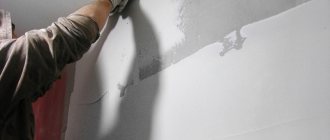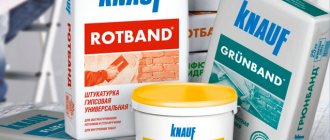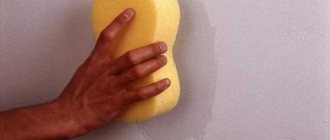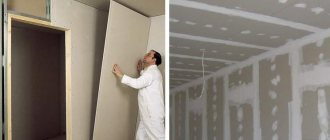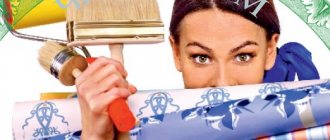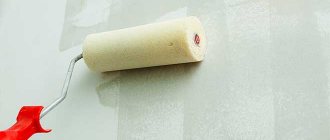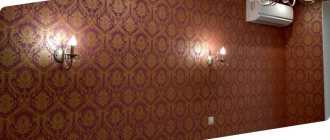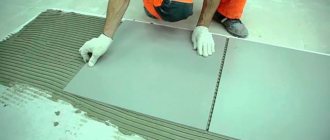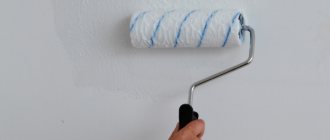Not a single renovation in the USSR was complete without newspapers. They were not laid on the floor, but glued directly to the walls. Why were the walls covered with printed publications, and how difficult was it for ordinary Soviet citizens to glue wallpaper?
Newspapers were used in many ways in the USSR. They replaced clothes, rugs and curtains. Sometimes Soviet people found completely unexpected uses for thick printed paper.
Difficulties of Soviet repair
Today, before wallpapering, the walls are primed. Construction compounds perfectly hide unevenness. In the Soviet Union there was no such luxury. Wallpaper pasted directly onto the wall only emphasized the ugly relief. Another factor is the quality of the wallpaper itself. In the USSR there was no non-woven or vinyl wallpaper - only paper. The paper tore from any sudden movement. The renovation was turning into a disaster.
Thick newspaper sheets lined the walls well. It is for this reason that “wallpaper” artifacts are sometimes discovered in old apartments: several layers of paper on the walls. Wallpaper pasted on newspaper was less likely to tear. Thick paper was also often used due to poor-quality glue.
freesmi_by
Shortages of various everyday goods existed in the Soviet Union from the very beginning and were the object of a huge number of popular jokes and anecdotes. One of the most common reasons for jokes, along with sausage, has always been newspapers, which the savvy Soviet people used not only for reading, but also for many everyday purposes. This universal product was used instead of toilet paper, instead of cat litter, they were used to stuff wet shoes to dry them, and if there was no tablecloth, they were laid on the table. They also glued newspapers to the walls. In this article we will tell you why this was done and why it was necessary.
Old wallpaper. Photo: factroom.ru
Reasons and history
Those who never lived during the era of the USSR cannot imagine the lengths to which Soviet people went to organize their life in conditions of a constant shortage of household goods. In the second half of the last century, our usual procedure for wallpapering an apartment was fraught with many difficulties due to the fact that good finishing materials were in short supply or were not sold at all. Each pasting faced the following problems:
Why were newspapers glued?
Inventive Soviet citizens came up with their own solution to all problems at once - newspapers that were sold in huge circulations, cost a penny and were always available. Not as a replacement for wallpaper, but only as a lining that served as a basis for wallpaper. This method compensated for many of the disadvantages of materials:
As has already become clear, the process of gluing wallpaper in a typical Soviet apartment was much more complicated than in a modern new building. The specialist was required to carry out a whole range of procedures:
Why pasting with newspapers is no longer relevant
Nowadays, the need for waste paper substrates has completely disappeared. This was due to several reasons:
Conclusion
What conclusion can we draw? The use of newspapers as a basis for wallpapering was not a whim or a way to save money for Soviet citizens, but an urgent necessity. The lack of high-quality glue, thin single-layer wallpaper, uneven walls - all this forced our mothers and grandmothers to be creative and use what was at hand. But remember that, despite everything, the Soviet wallpaper held out.
Source
Repair in the USSR: glue on the slab
Wallpaper glue was literally cooked. The compounds could not simply be bought in a store. To make a paste, starch was diluted in water. This solution was then boiled down. Sometimes starch was replaced with flour. This “glue” glued the paper to the wall well, but took a very long time to dry. Thin and damp paper wallpaper often took on an unpresentable appearance.
The wallpaper set faster with newspaper. The result was fewer cracks, defects and bubbles. After drying, the glue lasted a long time. There was, however, a significant drawback. Cockroaches and bugs infested houses, for which dry paste was a real delicacy.
Preparation of materials and tools
Making liquid wallpaper with your own hands is quite simple. To work you will need the following components:
- newspapers;
- clean warm water, which will serve as the basis for the future composition;
- tinting pigment for water-based paints (color selected according to individual preferences);
- PVA glue for strength and elasticity of the solution;
- alabaster is predominantly of high quality.
The following tools should be prepared:
- a drill or screwdriver with a special mixer attachment for grinding paper to the desired consistency;
- bucket or other container for solution;
- putty knife.
Why else do they glue newspaper under wallpaper?
Several layers of newspaper hid the defects. In addition, the glue dried faster between the newspaper and the wallpaper. However, these are not all the advantages of such a “primer”.
Oddly enough, newspapers increased the life of plaster. Walls without a printed layer crumbled faster. Along with the plaster, the new wallpaper came off. But even on strong walls, the wallpaper did not fit properly. Without impregnation and a durable backing, sooner or later the wallpaper began to “slip.” The room took on an unkempt and uncomfortable appearance.
Technology for creating inexpensive decorative plaster from paper and newspapers
Paper is a material formed by cellulose fibers glued together. This material, warm to the touch, is suitable not only for all kinds of notes, drawings or drawings, not only for origami crafts or papier-mâché souvenirs. Paper pulp has long been used as a building material. Paper plaster was used to level and insulate walls even before the revolution.
Types of cheap paper plasters
Once upon a time, newspapers were glued to walls and partitions in several layers to seal cracks and prepare them for wallpaper. In addition, there was a technique for making and applying paper plaster from waste paper. With a little “magic”, paper is used to create original vestments for the walls of any room.
You can choose and do it yourself:
- plaster made of paper glued to the wall with a crinkled silk effect;
- homemade liquid wallpaper;
- plaster from newspaper rolls.
Advantages and disadvantages of coating
Like everything else in the world, this type of inexpensive finishing has its own pros and cons.
- paper plaster is the cheapest wall decor;
- excellent thermal insulation properties;
- environmentally friendly;
- porous structure absorbs noise;
- high elasticity (does not create cracks during shrinkage);
- do not burn, extinguishing when ignited;
- vapor permeable;
- mask wall defects;
- The walls are warm to the touch.
Disadvantage: takes a long time to dry
Required materials and composition of plaster
The main raw material for paper plaster is, of course, paper. These can be sheets of stationery or notebook paper. Suitable paper is newspapers, egg trays, advertising brochures and other types of waste paper. It is not recommended to use cardboard, as its presence negatively affects the pliability of the finished plaster.
You will also need an adhesive base - CMC wallpaper and PVA glue. They are needed to give the paper pulp the ability to stick to the wall and connect its fibers to each other.
You can additionally add a coloring agent to the composition - color for acrylic paint. When painting decorative plaster from new paper, of course, the result is purer tones than a composition made from waste paper. It is also worth considering that when drying, the color of the plaster noticeably fades.
To make the paper covering more decorative, colored threads cut into short pieces, shredded tinsel, shiny ribbons for tying flowers and souvenirs, and shredded foil are added to the mixture.
To make the plaster resistant to fungus and mold, special bactericidal components are added. Sometimes sandless clay is added to the composition. It gives the mixture elasticity.
Not just a wall covered with newspapers
Newspapers in general were quite popular material in the USSR. They were used to make hats, packaging for anything, and “garbage bags.” Books were often wrapped in newspaper. This cover not only preserved the appearance of the publication. It allowed forbidden literature to be read incognito.
Sometimes newspapers were used in unconventional ways. Windows covered with newspaper are a common option for temporary curtains. Pots wrapped in thick paper lost heat more slowly. Newspaper was stuffed into shoes for drying: the paper absorbed moisture well. They even filled fur hats and fur coats with the press: the specific smell of the paint repelled moths.
How to use newspapers in decoration: 10 ideas with instructions
Newspapers can be used as colored paper, craft material, wallpaper, and even furniture! Here is a selection of handicraft ideas, from simple to very extravagant.
Newspapers as paper for decoupage / applique
As a rule, newsprint is quite thin and hygroscopic, so it can be used for decoupage or appliqué. Cut out the necessary parts from newspapers and glue them using a brush and decoupage glue. For durability, you can then coat everything with a special varnish.
How to decorate a flower pot: 12 decor ideas with instructions
Newspaper as a canvas
Newspapers can also be used as a canvas to create interior paintings. Here, two paper-covered stretchers were taken as a basis. The newspapers were torn into shreds and their edges were singed. Then they glued it onto the base. When the glue dries, you can paint.
How to use leftover wallpaper in the interior: 15 ideas
Newspaper as a poster
Maybe you still have a newspaper article that is somehow important or dear to you, or a page from an old newspaper whose design you like? Insert the sheet into the frame under the glass - the interior poster is ready.
How to decorate walls: 15 ideas for decorative panels with master classes
Frame decorated with newspapers
You can also decorate the frame itself with newspapers. Just tear the newspaper into pieces and glue them to the frame. You can “cut out” individual words or phrases and glue them on top.
How to decorate frames for photos, paintings and posters: 11 ideas with instructions
Newspapers for decorating a lampshade or floor lamp
This way you can update an old lampshade or change the appearance of a new one. Tear newspapers into pieces and cover the lampshade.
How to decorate a lampshade: 14 ideas with instructions
Newspapers for decorating gift bags
Newspaper is used here as colored paper. To make the bags stronger, first reinforce the newspapers with thicker paper. When the glue has dried, cut out the parts, fold and glue the bags, fill with gifts and decorate with a napkin and ribbon.
How to wrap a gift beautifully: 22 ideas
Garlands from newspapers
If you're decorating your home for a party, newspapers can be a great material for garlands. By the way, confetti can also be cut from newspapers, especially colored ones.
Photo: parenting.firstcry.com, theshinyhappypeople.com
Floral crafts: DIY paper daisy garland
Newspapers for furniture decoration
Why not decorate a piece of furniture, such as a chest of drawers, with newspapers? If you are ready for such a bold design decision, stock up on enough newspapers, decoupage glue and a brush and varnish. Prepare the furniture before work by cleaning and, if necessary, sanding. Apply glue to the furniture and glue pieces of newspaper, smoothing each one with a brush. Cover the finished work with varnish.
Painting furniture: 5 main rules and master class
Newspapers as a piece of furniture
An even more unusual way to use newspapers is to make something like a bedside table or stand for them. You can simply stack the newspapers - such a stand, of course, will not be too stable. You can cover thick cardboard rectangles with newspapers and then stack them and glue them together - the structure will be more durable.
DIY decoupage
Newspapers as wallpaper
Newspapers can also act as wallpaper - for example, you can use them to highlight an accent wall. For such a project, it is better to take newspapers with paper that is thicker, smoother, and not too loose.
Why is this necessary?
The main question that everyone who sees such a process asks is why do this. There may be several reasons for such non-standard use of periodicals:
- If you are going to decorate a room in which the walls are covered with lime plaster or other similar material, the adhesion of the wallpaper to the surface will not be very good. If you first cover the surface with paper, the base will better hold the wallpaper.
- In some cases, the base could crumble and was unstable. The pasted sheets of periodicals significantly strengthened the surface and subsequent finishing was much easier, without the risk of the plaster falling off and the panels peeling off.
- If there are small irregularities or scratches, glued pages will level out these shortcomings. When wet, the paper will swell and shrink after drying, forming a more even surface.
- This material can act as a topcoat rather than a base. In this case, you will get a very original interior design.
The main reason for using such techniques in finishing was the banal impossibility of buying a good primer or ordinary putty. We had to look for ways to strengthen and level the plane before finishing. At the same time, the pasting technology will be slightly different from working with traditional coatings, and a few tips below will help you figure out how to glue newspapers to the wall.
Examples
It doesn’t matter what the wall will look like after gluing periodicals as a base; anyway, this surface will be hidden by the finish. If you are decorating your home in an original way and gluing newspapers to the walls will be just a decoration, then a few photo examples of how it can look in the interior will help you choose one of the finishing options with this material.
Pasting technology
Fundamentally, the process of gluing this mole material will differ from working with standard wallpaper. However, when gluing rooms with crumbling walls or covered with lime, the work will proceed a little differently.
- First, you need to clean the entire surface of dirt and inspect any crumbling or peeling areas. Having identified such defects, you need to get rid of them - remove the peelings and level the surface using plaster or putty compounds, not forgetting to first prime the areas to be repaired.
- When the putty dries, the entire surface needs to be primed again. You can apply a special base-strengthening composition - there is a large selection of suitable mixtures in stores.
- Further, much will depend on how the newspaper sheets are intended to be used - as a base or a finishing coating. If this is a base, then the surface of the wall is covered with glue and allowed to dry completely. After this, glue is again applied to the wall and the paper is glued to it.
Important: do not try to spread glue on the paper itself - it tears easily when wet and you won’t be able to transfer the soaked sheet onto a flat surface.
- If you want to get an original wall finish, then newspapers can be pasted after preliminary preparation. It involves cutting off the edges of the pages to get rid of uneven edges. In addition, after such pruning, the sheets look better and the design is more interesting. The rest of the technology is similar to the previous point.
Cooking technique
Making liquid wallpaper is a fairly simple task and consists of several stages:
1. You need to take 200 g of paper (the quantity can be calculated depending on the required volume), cut into strips or torn into small pieces, then placed in a bucket and filled with 1.25 liters of warm water.
Related article: Nuances of choosing a laminate to wallpaper color: successful combinations of shades
Paper or newspaper is cut and filled with water
2. To completely soak and soak in water, the composition should be infused for about an hour.
3. Then, using a drill or mixer, the solution must be stirred and crushed until smooth.
Using a mixer, bring to a homogeneous mass.
4. Add 2 caps of paint of the selected color to paint it in the desired tone.
Add paint and glue
5. After that, 20 g of PVA glue is poured into the solution and everything is thoroughly mixed again.
The mixture is thoroughly mixed
6. At the last stage, 200 g of gypsum is added. The material sets quickly, so immediately after this you should begin applying the solution.
Sparkles or colored fibers can also be added to the liquid, which will add even more originality to the finish.
On video: liquid wallpaper from newspapers.
